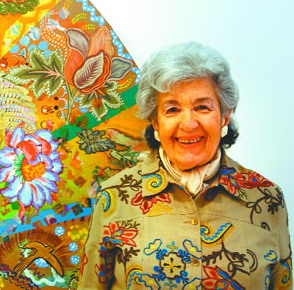Artist Miriam Schapiro passed away last week at the age of 91. Schapiro was a ground-breaking feminist artist who helped bridge the gap between “high art” and craft, especially traditional women’s crafts such as quiltwork and decoration. She affixed fabrics directly to her canvases and combined them with acrylic paint and even glitter to create her finished works. Schapiro referred to these works as “femmages,” and intended them as a deliberate challenge to an art world that systematically devalued women’s work as sentimental and decorative, an idea she took on directly. Rather than argue that the work was not sentimental, she instead stated: “Men think that sentiment is not valid; women think that sentiment is important.” This point of view was very much in line with the feminist movement in the 1970s, whose rallying cry was “The personal is political.” But Schapiro took up the cause of a feminist vocabulary in art, and she became a leading artist of the Pattern and Decoration Movement, which contested the art world’s bias against decoration.
Schapiro began her career making geometrical abstract paintings, but a major shift in her work occurred after she worked in collaboration with feminist artist Judy Chicago on the massive installation Womanhouse in 1972. The project took over an abandoned mansion in Hollywood and parceled each room out to a different female artist for her personal interpretation and installation on the theme of the domestic lives of women. Schapiro’s contribution, in collaboration with Sherry Brody, was Dollhouse, featuring a set of six miniature rooms, each of which represented various societal roles and expectations for women: a kitchen, a nursery, a parlor, two bedrooms: one a satin-and-feather-bedecked star’s boudoir and another a richly draped and carpeted seraglio, and finally an artist’s studio. None of the rooms featured entrances or exits, and each combined some aspect of a woman’s life with elements of entrapment or nightmare.
The work fundamentally changed the way Schapiro thought of her work and what was possible. “Right after Womanhouse, I glued fabric on the painted surface of the canvas,” she explained. “And that was really a no-no as far as New York was concerned. In fact, [Abstract Expressionist painter] Al Held said of me (I had a lot of New York admirers before I came to California), ‘Well, she left the true faith.’”
Schapiro’s inclusion of “decorative” elements in her work set her beyond the pale of the accepted boundaries of what was considered fine art. But Schapiro took up the cause of a feminist vocabulary in art, and later, with artist Robert Zakanitch, was one of the founders of the Pattern and Decoration Movement, which contested the art world’s bias against decoration.
Schapiro’s work in Crystal Bridges’ collection, A Mayan Garden, 1984, pays homage to a traditionally feminine accessory, the folding fan, in a brilliantly colored shaped canvas collaged with a riot of flowers and patterns from traditional Mayan clothing.








